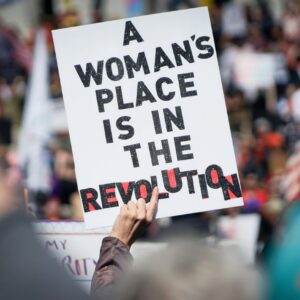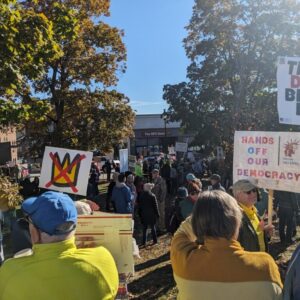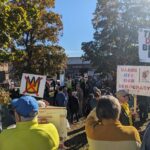
State of the Movements is a recurring NPQ column dedicated to tracking the pulse of social movements and the solidarity economy in 2025.
“If DC goes and we’re the nation’s capital, everybody else is…” trailed off Niciah Mujahid, executive director of DC’s Fair Budget Coalition.
“Cooked!” the crowd roared.
Mujahid was speaking at the annual People’s Budget Forum, held this year on September 20, one block east of the White House. This event is just one example of how residents have come together and are standing up to defend their rights.
What’s happening in the nation’s capital is a harbinger of worsening political repression.
In addition to Fair Budget Coalition and Center for Economic Democracy, Free DC and the DC Fiscal Policy Institute (DCFPI) are working to organize residents to resist federal overreach.
But to keep this test of authoritarianism from being increasingly replicated in other cities, advocates throughout the country must double down on their solidarity efforts.
Impacts of the Takeover
Since the National Guard began to occupy the District of Columbia on August 11, the effects on the city’s Black and people-of-color working-class communities have been significant. Residents have shared accounts of federal law enforcement targeting and harassing young people for things as mundane as metro fares, racially profiling and overpolicing Black and Latine residents, and brutally clearing encampments of the unhoused.
Despite the stated aims of President Donald Trump’s administration to confront “crime, bloodshed, bedlam, and squalor” here, the truth is that in 2024 the city reported its lowest overall crime rate in over 30 years. The impacts of the military occupation extend far beyond district lines: What’s happening in the nation’s capital is a harbinger of worsening political repression.
Early in the takeover, the arrest rate increased by 25 percent, with 80 percent of those arrests for misdemeanors, warrants, or traffic offenses. Additionally, CourtWatch DC reported that in a four-day period in September, more than 70 percent of requests to hold defendants accused of a crime (including nonviolent crimes) in prison without bond were granted, meaning the majority of residents were held in jail until they were charged.
So, what do these numbers mean for Black people, people of color, and working-class communities?
Residents in district neighborhoods that are being more frequently patrolled by federal forces have often foregone small pleasures, such as frequenting their favorite restaurants. This in turn impacts local businesses and the local economy.
Black residents in DC were already overpoliced—83 percent of all 2024 arrests were of Black people in a jurisdiction where only about 45 percent of the population is Black.
Adding federal law enforcement to the mix has only increased the trauma of police encounters. From post-traumatic stress disorder to job insecurity, the results of overpolicing affect individuals and their communities for years.
The administration is also targeting immigrant communities in DC, sending masked ICE agents to patrol the streets with broad impunity after a US Supreme Court ruling cleared the way for racial profiling. This echoes the administration’s focus on deepening police cooperation with immigration enforcement nationwide.
It also highlights how ICE intends to leverage local law enforcement of low-level infractions to indiscriminately detain immigrants, as ICE struggles to meet the White House’s quota demands of 3,000 migrant arrests per day. For example, from September 11 through September 19—a mere eight days—DC’s Migrant Solidarity Mutual Aid hotline received nearly 500 phone calls from immigrants in the city witnessing the brutal kidnapping of their loved ones.
According to data retrieved by the Deportation Data Project, ICE had made only 85 arrests in the district from January 20 through the end of July. From early August until mid-September, ICE made around 1,200 arrests in DC, in close partnership with both the Metropolitan Police Department and the US Park Police. With immigrants comprising 18 percent of the city’s workforce, the implications for the construction, childcare, and healthcare industries—where immigrants are disproportionately represented—are especially dire.
Nearly 1,000 unhoused residents are also feeling the impacts of overpolicing and dehumanization along with the disintegration of their communities, as their encampments are bulldozed and personal belongings disposed of. With little to no regard for providing shelter or housing, cruelty appears to be the point.
Ironically, only a few years ago, the district government had claimed to be committed to ending chronic homelessness and funding housing vouchers for all people experiencing homelessness. But now, as the Trump administration applies increasing pressure for these kinds of sweeps, Mayor Muriel Bowser has the cover she needs to increase raids—which certainly predate Trump’s current administration—despite vehement opposition from advocates and community members.
The Financial Cost
In 1973, President Richard Nixon signed the DC Home Rule Act into law, which enables the mayor and DC Council, both elected by residents, to make local decisions about the district’s laws and budget.
State-level base-building organizations can help expand the congressional bloc defending DC home rule.
However, home rule has always been limited, with Congress—driven by racialized dog whistles—often passing legislative riders that have overruled local decisions; examples are legion, for instance, in 2023, Congress overrode DC legislation to liberalize the district’s criminal code. More recently in April 2025, Congress withheld $1.1 billion from the district’s $21 billion budget, reverting it back to its 2024 fiscal year budget and forcing unnecessary midyear cuts to appropriated public services for residents.
Though the financial burden of the occupation is most egregious for DC residents—the latest data show that DC taxpayers can expect to pay over $200 million for the deployment—US taxpayers in other localities are also footing the bill to the tune of $1 million per day. States like Louisiana, Mississippi, Tennessee, West Virginia, and Ohio have deployed anywhere between 150 and 400 National Guard troops. South Carolina, too, sent 200 members of their National Guard to DC, while hurricane warnings were impacting their own residents.
What Can Advocates Do at the State and Local Levels?
In an open letter signed in late September by 151 national, state, and local organizations across a range of issue areas—including labor, faith, civil rights, justice reform, and human rights—the signatories called on Congress to reject any proposed legislation that undermines the district’s authority to govern itself. While it is critical for organizations with a national reach to sign on, educate, and organize their allies, state-level base-building organizations can help expand the congressional bloc defending DC home rule.
Members of Congress—especially those who are undermining DC’s autonomy—need to hear from their constituents. For example, Free DC identified 31 Democrats in the US House of Representatives that voted yes on HR 4922, which severely restricts the city’s ability to adapt its own sentencing laws. Another eight voted yes on HR 5140, which allows for minors as young as 14 to be tried as adults in the district for certain crimes.
What Can Funders Do?
Earlier this month, Aisha Alexander-Young, a DC-based philanthropy professional, called on funders to stand up for DC, noting that the district is often a “political laboratory where anti-democratic tactics are refined before they are exported across the country.” Stopping these tactics in Washington, DC, in short, helps protect communities across the United States.
Funders, in addition to supporting groups organizing on the ground today, can meet the moment by:
- Investing not only in advocacy but also in the long-term work of structural organizing, base-building, and political education among marginalized communities
- Dedicating resources to formations beyond 501c3s, including c4s, cooperatives, collaboratives, and mutual aid organizations
- Expanding practices of resource mobilization to include wellness funds, executive coaching, training and capacity building, and facilitating cross-movement and cross-funder connections
Movements must counter these harmful narratives by offering more nuanced conversations about race, poverty, and crime.
Developing Our Own Narratives
Trump, when talking about Washington, DC, routinely spews racialized, anti-poor, and ahistorical vitriol about “lawlessness.” But the current attack on DC is not about crime. Rather, it is a classic use of dog-whistle politics to foment racial prejudice and divide working class people along racial lines, thus consolidating power for its administration and its wealthy allies.
Movements must counter these harmful narratives by offering more nuanced conversations about race, poverty, and crime. Decades of sociological research have shown that crime is not simply a result of “violent gangs and bloodthirsty criminals.”
In fact, crime’s root causes are social—from poverty and un/underemployment to a lack of affordable, quality housing and healthcare. All of this makes the simultaneous rollback of social services, both through federal civil service job cuts and the budget bill passed by Congress in July, even more harmful.
This is an intentional, calculated strategy against DC, and it is providing a model for other cities. It’s critical to effectively communicate that anti-democratic interference in DC undermines the security of democratic principles across the country.
Solidarity in Action
Why has Trump targeted DC? Certainly, its federal district status makes it vulnerable. But another reason is that the nation’s capital is in many respects an economic justice leader. Repression helps rein in the “bad example” of progressive policies that work. As Elizabeth Falcon, executive director of DC Jobs with Justice, shared with NPQ, “DC does more to address economic injustice than most other places in the country.”
Indeed, DC’s ability to govern itself has led to significant innovations in tenant rights (such as its Tenant Opportunity to Purchase Act, or TOPA, which has become a national model); public benefits (DC has one of the lowest uninsured rates in the country); and paid family leave (used as a template for many other localities nationwide).
As this occupation of our nation’s capital continues through at least November 30, it is essential that the resistance extends beyond the beltway. The threats posed to other US cities are obvious, as seen in recent efforts by the Trump administration to send National Guard troops to Memphis, TN, and Portland, OR.
For those individuals and organizations who have a higher structural risk tolerance, we encourage them to be bold in the face of this military takeover and fight for political, economic, and narrative power.
For others who face the threat of retribution and might need to be more circumspect, we suggest having conversations with those in your own trusted circles, sounding the alarm for what is to come.
At this moment, the words of Pastor Martin Niemöller in his post–World War II poem “First They Came” are more poignant than ever. Let us not wait until they come for Philadelphia, Chicago, New Orleans, Baltimore, or other cities, lest there be “no one left to speak out” for us.














